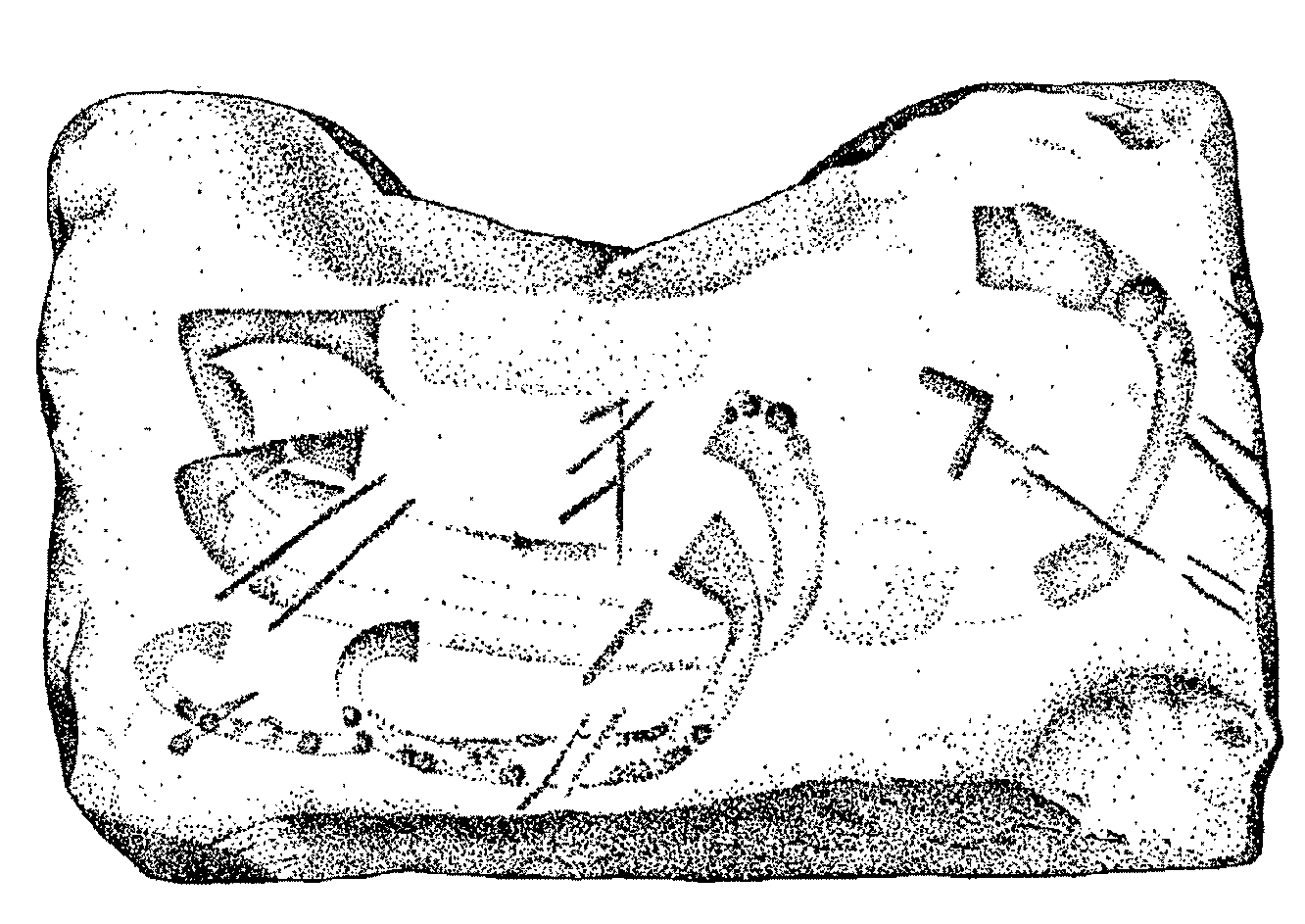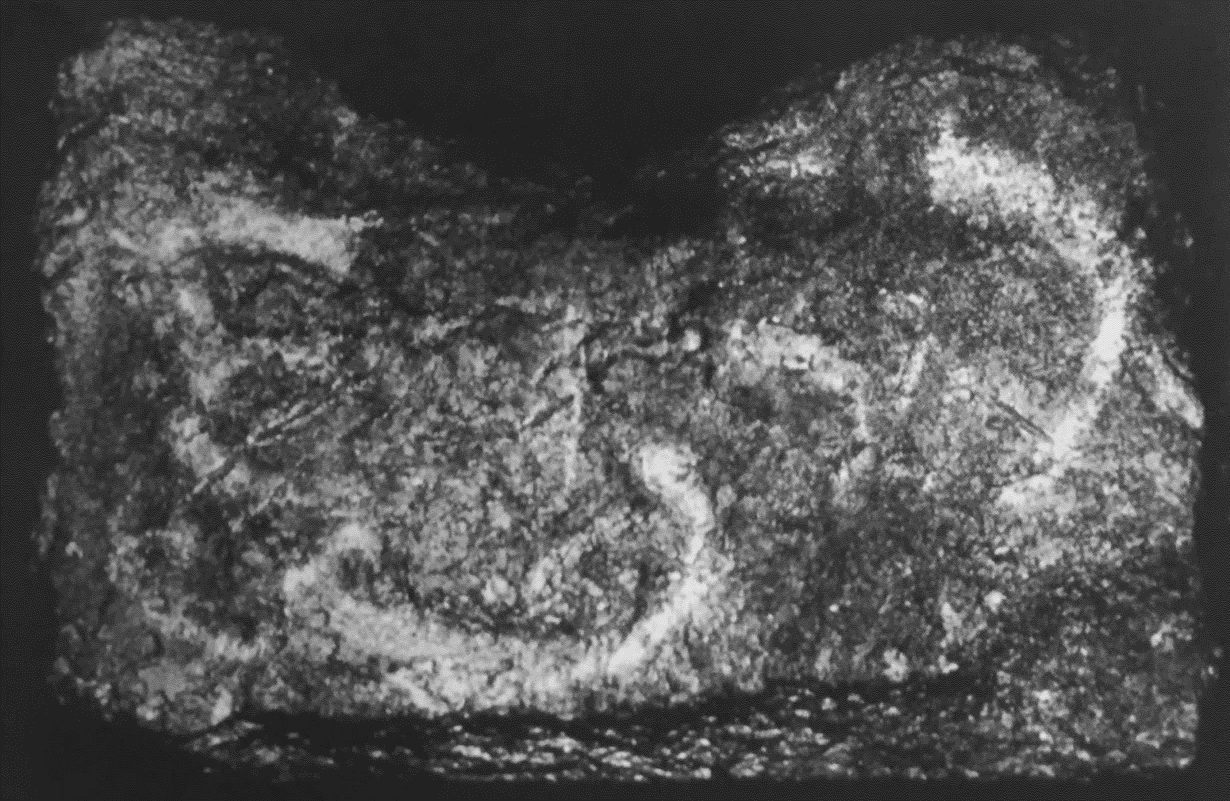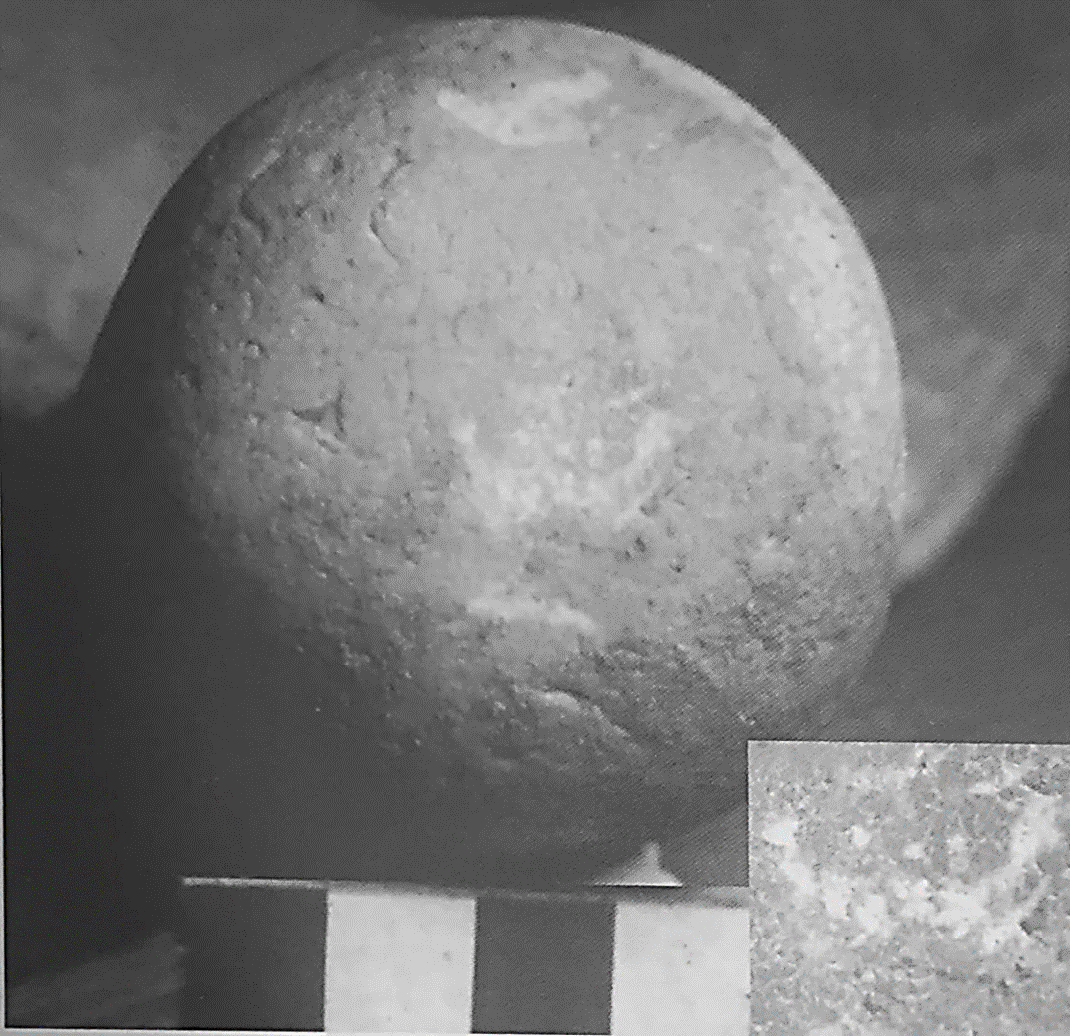Altar graffiti (L6): the topmost and largest of the four graffiti is
also the most detailed. This ship can be confidently identified as
facing left, thanks to the presence of two quarter rudders, one of which
has an attached L-shaped tiller (T). It has a flat hull with a high
incurving sternpost. The curving stempost is shorter, and bends sharply
inward at the top - almost at a straight angle - running parallel to
the hull and ending in a flaring extremity which Artzy describes as a
"fan." The mast is roughly amidships, with three oblique strokes
crossing it which are possibly shrouds and a sail above (S). There are
possibly two oars in the bow section which were rendered with deep
incisions. Their orientation and the fact there are only two is however
curious. The remaining three ships are of smaller, progressively
decreasing proportions, but are otherwise very similar in shape and are
clearly meant to depict the same type of vessel. Unlike the largest ship
however, these show only the hulls, with the exception of ship 2 which
also possibly has two oars. When compared separately, it becomes clear
that the sternposts and the flaring bow devices of the four ships are
similar albeit not identical. This is to be expected given the medium as
well as some of the accommodations that the artist had to make in such
an overlapping composition.
Quartz pebble graffito (L7): the ship is very small (< 2 cm in
width) making its details difficult to discern. It has two rounded ends
and high posts, with the right one slightly higher. Artzy interprets the
ship as facing right, and notes that the stempost has an everted
extremity which possibly consists of an animal-headed device. The
sternpost does not seem well defined.
Portable altar ship graffiti
L6-L7
End of 13th- beginning of 12th century B.C.
Akko, Area H (square L-7)
Altar: 30 x24 x 26 cm
Portable stone altar; quartz pebble
Artzy 1984: 59-64; 1987: 75-83, figs. 1,2; 1988: 182, fig. 1; 1994: 33; 2003: 232-33, figs. 1, 10; 2006b: 117-18, figs. 2, 3; Knapp 2019: 126-127, fig. 28
The earliest evidence of occupation on the flat surface atop Akko's rampart dates to the end of the 13th and the very beginning of the 12th century B.C., with all three areas examined (H, PH and AB) uninhabited throughout the Amarna period despite written evidence attesting to the existence of the site, which must have been located elsewhere during the LBA. Each of these areas varies in the nature of human activity: area AB has been identified as an industrial zone (furnace, thick ash layers), area H is defined as cultic in nature (altar), and area PH as a living quarter.
The altar was found in Area H, about 5 m away from a pit that contained fragmentary pottery (storage jars, miniature storage jars, and a krater) which had been thrown and smashed by stones. It was connected by a row of stones to a partially stone-lined bothros containing large amounts of ash and some sherds. On top of the altar was more ash and three pebbles roughly the size of an orange, bearing representations, including a small ship, a dolphin, a bird (?), another fish (dolphin or tuna), and additional signs which have not been deciphered. The pebble with the engraving of the tiny ship, a fish and possibly a bird is made of quartz, a rock which is not indigenous to the region.
Artzy notes that the altar is oddly shaped, especially its base, which combined with its small size suggests that it was portable (Artzy 2003: 232; 1987: 76). If this hypothesis is correct, it is possible that the altar was in a secondary use, and might have originally served aboard a ship. The widest, front face of the altar bears the graffiti of four ships of varying sizes superimposed on one another in an integrated composition. These decrease in size from top to bottom, with the largest one spanning nearly the entire width of the altar. The smallest ship on the bottom left appears incomplete, with its stern missing. As the graffito overlaps with the third ship at this location, it is possible that the stern simply became indistinguishable when the two were superimposed. The artist used multiple engraving techniques, including grooving, drilling, and plain incisions. Much of the biggest ship was incised, including the mast, brails, oars, tiller and lower rudder. Grooving was used to highlight the stem of the ships, while the hulls were rendered by drilling.
The fan-shape of the stempost device which Artzy has
stressed at great length is perhaps overemphasized. She concedes herself
that the stern extremity of the ships also has a triangular end, but
notes that it is not accentuated in the same manner. She argues that
"[...] the engravers took great care in the representation of the
fans. The clear-cut formation and the depth of the fans show that they
were of paramount importance to the artists" (Artzy 1987: 77). Finally, she notes
that the proportions of these "fans" are difficult to make sense from a
technological point of view, leading her to hypothesize that they were
purposefully exaggerated in order to accentuate their ritual importance.
There are discrepancies however between the two drawings available, with
some of the extremities not flaring nearly as much as one would gather
from the description, especially for the smaller ships. The photograph
does not help clarify this point unfortunately so a re-examination is
warranted. The one secure observation that can be made is that the ships
have two clearly rounded ends with incurving extremities, with the
sternpost decidedly higher and its inward curve less pronounced, while
the stempost has a much more exaggerated, sharp inward bend. As such
these ships are clearly different from contemporary Aegean type, with
the bow projection and vertical stempost conspicuously absent.
The
artist has made certain concessions due to available space and the
nature of the composition. The largest ship 1 was thus given
considerably more details, while the rest were limited to the hull
outline only. This also explains why so few oars are depicted - only
two for ship 1 and 2 respectively - as the addition of more would have
greatly impacted the clarity of the composition which is already
cluttered due to the superimposition.
Artzy, M. 1984. “Unusual Late Bronze Ship Representations from Tel Akko,” MM 70: 59-64.
―――. 1987. “On Boats and Sea Peoples,” BASOR 266: 75-84.
―――. 1988. “Development of War/Fighting Boats of the Second Millennium B.C. in the Eastern Mediterranean,” RDAC: 181-86.
―――. 1994. “On boats, on Rocks and on ‘Nomads of the Sea,’” CMS News 21.
―――. 2003. “Mariners and their Boats at the end of the Late Bronze and the beginning of the Iron Age in the Eastern Mediterranean,” Tel Aviv 30: 232-246.
―――. 2006b. ““Filling in” the Void: Observations on the Habitation Pattern at Tell Akko at the End of the Late Bronze Age,” in A. M. Maeir and P. de Miroschedji (eds.) “I Will Speak the Riddles of Ancient Times.” Archaeological and Historical Studies in Honor of Amihai Mazar on the Occasion of his Sixtieth Birthday. Vol. 1 Winona Lake: Eisenbrauns, pp. 115-122.
Knapp, A. B. 2018. Seafaring and Seafarers in the Bronze Age Eastern Mediterranean. Leiden: Sidestone Press.









